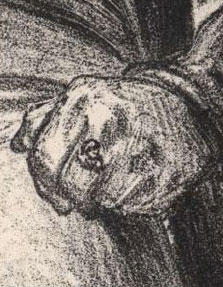- Relief printing
- Intaglio and planographic printing
- Color printing
- Bits and pieces
- Early photography in silver
- Non-silver processes
- Modern photography
- Color notes
- Color photography
- Photography in ink: relief and intaglio printing
- Photography in ink: planographic printing
- Digital processes
- Where do we go from here?
Stone Lithography Process

Stone lithograph. Artist unknown. Propositions de la Russie. c. 1885. 9 7/16 x 10 7/8" (24 x 27.6 cm). The Museum of Modern Art, New York. Gift of Richard Benson.
Lithographic printing is done from the smooth surface of a piece of limestone. The artist draws directly on the stone, using a crayon composed mainly of beeswax and dark pigment (to give visibility). After the drawing is done the stone is treated with a weak acid called “etch”—like “engraving,” a very confusing word. In intaglio printing the etch removes material from the surface; in lithography it doesn’t alter the height of the surface but rather induces a chemical change, leaving the surface—wherever it isn’t covered by the crayon—in a state that will hold a continuous film of water when wetted. The crayon is then removed with a solvent, but the limestone under the drawing retains the crayon’s ability to repel water.

Detail of Stone lithograph. Artist unknown. Propositions de la Russie. c. 1885. 9 7/16 x 10 7/8" (24 x 27.6 cm). The Museum of Modern Art, New York. Gift of Richard Benson. This three-times enlargement shows the grain of stone lithography’s black crayon, which allows it to create the illusion of tone.
Once etched and cleaned, the stone is carefully worked up with ink and water to stabilize the printing image. Repelled in its turn by the damp areas of the stone, the ink adheres only to the area of the drawing. Repeated applications of ink and water allow the stone surface to print many copies. If a lithographic crayon has been properly made—often with additional materials added to the wax and pigment—the lines it draws take on a fine grain that can range from light to dark. The ink particles are still black, but their size varies, and so lithographs have the wonderful ability to give the appearance of tonal variation. Like etching, lithography responds beautifully to the hand of the artist, and much original work was done in this medium when it was used to print cartoons and satires in newspapers during the nineteenth century.

